
A smartphone is a mobile device that combines the functionality of a traditional mobile phone with advanced computing capabilities. It typically has a touchscreen interface, allowing users to access a wide range of applications and services, such as web browsing, email, and social media, as well as multimedia playback and streaming. Smartphones have built-in cameras, GPS navigation, and support for various communication methods, including voice calls, text messaging, and internet-based messaging apps.

The Samsung SGH-U600, introduced in 2007, is a mobile phone manufactured in South Korea by Samsung and is part of the Ultra Edition II series of Samsung phones. It is a sliding phone and the thinnest phone of its time. One of its main features are the call and select buttons, which are touch-sensitive instead of physical buttons.

The Sony Ericsson K850i is a high-end mobile phone when released in October 2007. It was announced in June 2007 as the flagship product in Sony Ericsson's K ("Kamera") series, with a 5 megapixel CMOS camera sensor. The K850 was the first Sony Ericsson phone released outside of NTT DoCoMo to support microSD and microSDHC along with Sony's traditional M2. It also introduces the usage of three touch-sensitive softkeys right under the display and a new form of navigation button, omitting the classic joystick introduced with the Ericsson T68. The camera interface has been revamped to resemble the format of cybershot digital cameras. According to the manufacturer the UMTS talk time has been significantly increased to 3 hours 30 min over its predecessor, the K800 and K810.. It was Sony Ericsson's first 3.5G HSDPA supporting mobile phone, and was also the first 3G "global" mobile with supporting all major operating network frequency in the world including GSM 850, GSM 900, GSM 1800, GSM 1900, HSDPA, UMTS 850, UMTS 1900, UMTS 2100.

The Samsung SGH-i900, also known as Omnia I or WiTu, is a smartphone created by Samsung Mobile. Announced in June 2008, the Omnia was launched in Singapore in mid-June, available in stores on the 20th of June, and in the rest of Asia in July. For some parts of Europe, it was launched in August. It was made available for the United States in December 2008 through Verizon Wireless and for Canada in April 2009 through Telus Mobility.

Samsung GT-i8910 Omnia HD is a smartphone manufactured by Samsung Electronics, first announced at MWC 2009 on February 18, 2009. The device was the first phone capable of playing and recording 720p HD video. It runs on the S60 5th Edition (Symbian^1) platform, the only Samsung device to do so.
The Samsung Behold II is a touch-screen, 3G- compatible smartphone with a 5.0-megapixel camera. The Samsung Behold II is powered by the Android OS, making it the fourth Android powered phone by T-Mobile USA. Other Android powered phones by T-Mobile are the G1, myTouch 3G, and the Motorola CLIQ. It was released on November 18, 2009. On May 27, 2010, Samsung announced that Android 1.6 "Donut" would be the final firmware release for the device.
The Samsung SCH U960 is a CDMA touchscreen side-slider cell phone made by Samsung, which was released in the U.S. on September 8, 2009.
Samsung B7610 is a smartphone produced by Samsung as part of their Omnia Series line of mobile phones. The B7610 OmniaPRO runs Windows Mobile 6.1 or 6.5 Professional, with a TouchWiz 2.0 user interface. The phone has a physical and virtual QWERTY keyboard.
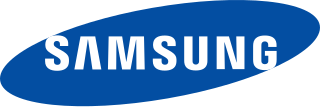
The Samsung Wave is a smartphone developed and produced by Samsung Electronics. It is the first smartphone to run the Bada operating system developed by Samsung Electronics, which was commercially released on May 24, 2010. The Wave is a touchscreen phone powered by Samsung's "Hummingbird" CPU (S5PC110), which includes 1 GHz ARM Cortex-A8 CPU and a built-in PowerVR SGX 540 graphics engine. It also has a "Super AMOLED" screen and 720p high-definition video capture capabilities. Due to shortage of Super AMOLED screens, Samsung released a successor to the device called Wave II and ceased production of the original S8500 model.

The Samsung Galaxy S is a touchscreen-enabled, slate-format Android smartphone designed, developed, and marketed by Samsung Electronics; it is the first smartphone of the Samsung Galaxy S series. It is the first device of the third Android smartphone series produced by Samsung. It was announced to the press in March 2010 and released for sale in June 2010. Due to shortage of Super AMOLED displays, Samsung released a successor to the device called S scLCD or SL and ceased production of the original I9000 model.
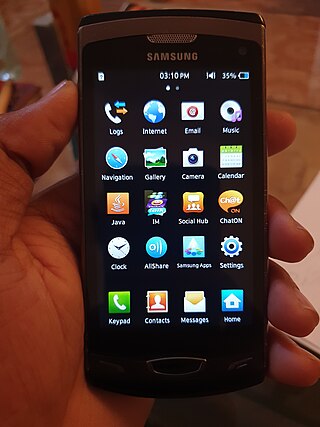
The Samsung Wave II S8530 is a discontinued smartphone developed and produced by Samsung Electronics. It is the successor of the Samsung Wave S8500 smartphone, and runs on Samsung's Bada 1.2 operating system, which was commercially released in October 2010. The Wave II is a slim touchscreen phone powered by a proprietary 1 GHz ARM Cortex-8 CPU and a built-in PowerVR SGX 540 graphics engine, SLCD display and 720p video recording. As the phone contained an LCD display, SlashGear speculated that the phone could be the result of a rumored AMOLED panel shortage.
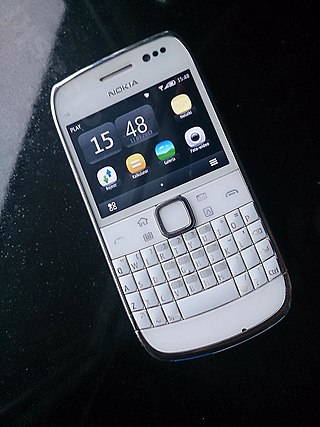
The Nokia E6-00 is a mobile phone running the Symbian^3 operating system. It supersedes the Nokia E72 as the new Symbian business mobility solution from Nokia following its announcement on 12 April 2011. It shipped with the new "Symbian Anna" version of Symbian^3, and originally retailed for 340 euros before taxes.
Nokia's strategic nomenclature can be traced back in 2005 when the Nseries line was launched, offering devices with flagship specifications and premium hardware at various price points. These devices were considered the "bread and butter" of the company and were often positioned to showcase their latest technologies. Thanks to the newfound consumer and enterprise interest in smartphones at the time, the company introduced four additional collections to diversify their product portfolio and meet demands in most market segments. These new phone series were named Eseries, targeting small business and enterprise customers; Xseries, providing consumer-grade multimedia-focused devices; Cseries, which Nokia used to target both the low-end and mid-range market segments; and Tseries, for devices exclusive to the Chinese market.
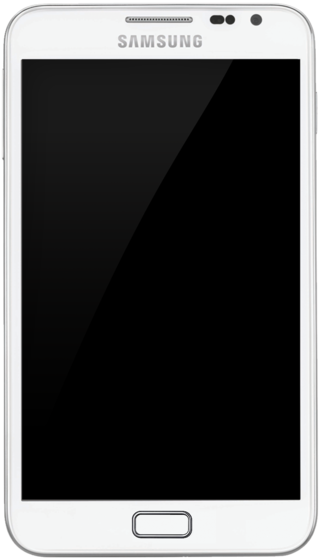
The Samsung Galaxy Note is an Android smartphone produced by Samsung Electronics. It was unveiled at IFA Berlin 2011 and first released in Germany in late October 2011, with other countries following afterwards. The Galaxy Note was distinguished by its unusually large form factor—later referred to using the term "phablet"—which straddled the size of the average smartphone at the time, and that of a small tablet: it features a 5.3-inch display, and is bundled with a stylus branded as the "S Pen", which can be used to navigate the device's user interface, and write or draw in supported apps.
The Samsung Galaxy Express (GT-I8730) is a smartphone made by Samsung which was launched in March 2013 in India featuring a similar design to the Galaxy S Duos but with additional features such as 4G LTE, NFC. It also features a bigger 4.5-inch screen with Super AMOLED Plus and retains all the features which the Samsung Galaxy S III phone has.
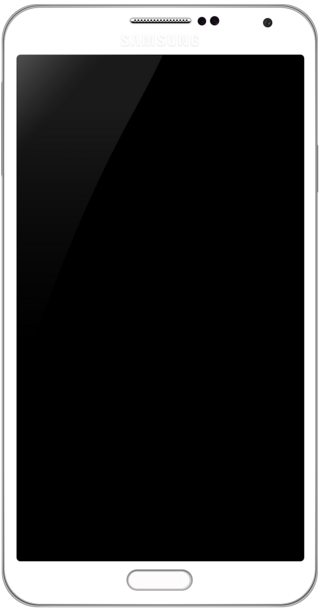
The Samsung Galaxy Note 3 is an Android phablet smartphone produced by Samsung Electronics as part of the Samsung Galaxy Note series. The Galaxy Note 3 was unveiled on September 4, 2013, with its worldwide release beginning later in the month. Serving as a successor to the Galaxy Note II, the Note 3 was designed to have a lighter, more upscale design than previous iterations of the Galaxy Note series, and to expand upon the stylus and multitasking-oriented functionality in its software—which includes a new pie menu opened through the button on the stylus for quick access to pen-enabled apps, along with pop-up apps and expanded multi-window functionality. It additionally features new sensors, a USB 3.0 port, 3 GB of RAM, and its video camera has been upgraded to 2160p (4K) resolution and doubled framerate of 60 at 1080p, placing it among the earliest smartphones to be equipped with any of these.
The Samsung Galaxy Express 2 (SM-G3815) is a smartphone made by Samsung which was launched in October 2013 featuring a similar design and specifications of the Samsung Galaxy S4 Mini but with a bigger 4.5 inch screen and different cameras.
Samsung Galaxy Star 2 Plus G350E is a smartphone manufactured by Samsung Electronics that runs on the open source Android operating system. Announced by Samsung in early August 2014. It has additional software features, expanded hardware, and a redesigned physique from its predecessor, the Samsung Galaxy Star 2.
The Samsung Wave 533, was launched on October 26, 2010 alongside the Samsung Wave 525. Both hardware and software-wise, the S5330 and Samsung Wave 525 are identical except for the inclusion of a pop-out keyboard on the Samsung Wave 533. The phone initially launched with a price of €150 ($210).
The Samsung Wave III S8600 is a smartphone running the Bada 2.0 operating system designed by Samsung, which was commercially released on August, 2011. The Wave is a slim touchscreen phone powered by "Scorpion" CPU, which includes 1.4 GHz ARM Cortex-8 CPU and a powerful graphics engine, "Super LCD" screen and 720p high-definition video capture capabilities. Shortage of Super AMOLED screens was one of the primary reasons for the release of this model.












